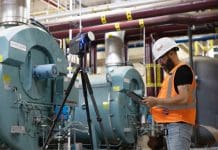Andrew Stolworthy of SFS explains why the company is embarking on a journey to start tracking how much carbon is embedded within its products
Sustainability has never been higher on the agenda but for architects and specifiers, there is an even greater challenge. The buildings now being planned or developed will stand for generations, meaning that the choice of what products to use is critical to the future of the built environment. This is particularly acute when it comes to the amount of embodied (sometimes called embedded) carbon in building products.
Understanding embodied carbon
Embodied carbon refers to all the carbon produced during the product’s life – which isn’t always easy to determine. A lot of the carbon you can’t see is locked in products, buildings and infrastructure.
When calculating embodied carbon, it’s important to consider the carbon footprint of manufacturing processes, as well as the materials used to create the product. Carbon emissions from the production of raw materials are part of the equation, as are those from shipping and transportation. In some cases, even assembling the parts into a finished product contributes to that product’s carbon footprint.
GHG emissions from the built environment can be divided into two categories: operational carbon – attributed to operational energy consumption during the building’s lifetime – and embodied carbon. Approximately 40% of energy-related GHG emissions are driven by generating buildings, while 11% is generated from manufacturing materials, according to the Carbon Leadership Forum.
Identifying embodied carbon
The key question is: how can the carbon footprints products be effectively defined to include accurate information on embodied carbon?
Construction products’ environmental product declarations (EPDs) are increasingly being used both in assessing buildings’ environmental performance and in comparing products for procurement decisions later on in the construction process.
However, identifying and purchasing low-embodied carbon products can be challenging because of a lack of data quality and the lack of transparency of EPDs.
Currently, the UK has no formal regulation regarding embodied carbon emissions, despite construction of new buildings and infrastructure accounting for more than 10% of the national total of emissions. The campaign group ACAN (Architects Climate Action Network) is demanding the introduction of regulatory legislation in line with countries such as France, Finland and the Netherlands.
Likewise, Part Z – a lobby group comprising architects, structural engineers and sustainability experts – is seeking a new section to be added to the Building Regulations requiring compulsory whole-life carbon assessments.
Getting verified
Such game-changing action will take time. Until then, it is vitally important that architects and specifiers can at least understand the carbon footprint of the products they choose. That’s why manufacturers must start, if they haven’t already, attaining verified EPDs and confirming that their products comply with European standard EN 15804.
This standard describes the technical performance of the product through its lifecycle, from raw materials through to manufacturing, construction, usage, maintenance, refurbishment and ultimately disposal.
The advantage of the verified mark is that it provides independent proof of the product’s sustainability, supporting compliance with Part L of the Building Regulations. For the manufacturer, there is the clear benefit of the product being recognised as fit-for-purpose from a sustainability perspective.
Yet there are additional advantages to complying with EN 15804. Knowing how much embodied carbon is used by a product provides a benchmark for future improvement and product development. Likewise, the data serves as a guide towards potential cost reductions in energy, transport or manufacturing.
Making a difference
It is for all of these reasons that SFS has signed up to the BRE’s EPD scheme – as well as being part of the UN Global Compact and supporting the principle of introducing Approved Documents to cap embodied carbon emissions on all major construction projects.
We are now implementing the BRE’s online measuring tool, LINA, which gives us access to best-in-class EPD methodology. This ensures there is a hard scientific basis behind the calculations of embodied carbon, bringing transparency back into the supply chain, as well as driving product innovation making more sustainable choices. We are currently in the process of getting our NVELOPE® subframe systems verified and will then roll out to other SFS products.
EPDs are but one of several measures we’ve adopted to help our customers make more informed choices about sustainability.
For example, the NVELOPE® Project Builder service for rainscreen subframes systems is an online tool that calculates all necessary considerations in a project’s initial planning stage. This not only allows for automated calculations of general building areas but also provides all component guides and list prices, NBS specifications and 3D modelling of thermal point loss areas.
Partnering Project Builder is our Thermal Lite tool. This calculates U-values, identifies sources of thermal bridging and offers specific, tailored guidance on reducing thermal performance gaps due to cold bridging.
These tools are all available through SFS’ ConnectSuite®, an online portal that hosts smart tools and apps like product selectors and visualisers to streamline specification and design processes – making the transition to digital integration as seamless as possible.
Securing futures
Architects and specifiers want only the best for their buildings – and any definition of “best” must include sustainability.
Whether by helping those architects and specifiers to make more informed choices today, or by challenging ourselves to think differently about how we source, manufacture and transport products, we’re excited by the possibilities. We are invested in knowing where our products go and how they interact throughout the whole lifecycle of the building – and, consequently, to see how we can make positive changes, even small ones, that will impact on the built environment.
At SFS, we believe in securing futures. After all, today’s building plans are tomorrow’s homes, offices, shops, hotels and hospitals. To secure those futures, the work starts right now.
Andrew Stolworthy
Director of Product and Market Development
SFS Group Fastening Technology Ltd
+44 (0)113 2085 500
Please note: this is a commercial profile.














